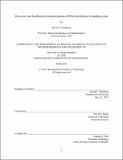Discovery and biochemical characterization of RNA interference in budding yeast
Author(s)
Weinberg, David E. (David Eric)
DownloadFull printable version (110.8Mb)
Other Contributors
Massachusetts Institute of Technology. Department of Biology.
Advisor
David P. Bartel.
Terms of use
Metadata
Show full item recordAbstract
RNA interference (RNAi) is a eukaryotic pathway for the post-transcriptional regulation of gene expression. In the simplest form of RNAi, a double-stranded RNA (dsRNA) trigger is converted into small-RNA duplexes by the Dicer enzyme. These duplexes are then loaded into the effector protein Argonaute to guide the cleavage of target transcripts. RNAi and related RNA-silencing pathways are found in plants, animals, fungi, and protists, suggesting origins in an early eukaryotic ancestor and selective pressures to maintain the pathway. A prominent exception to this widespread conservation of RNAi is the budding yeast Saccharomyces cerevisiae, which lacks homologs of Dicer and Argonaute. Indeed, RNAi had been presumed lost in all budding yeasts. Motivated by the presence of Argonaute homologs in some budding-yeast species, we examined whether these species contain a functional RNAi pathway. High-throughput sequencing led to the identification of endogenous small RNAs that are generated by a novel Dicer enzyme. In Saccharomyces castellii, these Argonaute-bound small RNAs serve as guides to repress mRNA targets, which are predominantly repetitive elements. RNAi can be restored to S. cerevisiae by introducing the genes encoding S. castellii Dicer and Argonaute, and the reconstituted pathway silences endogenous transposons. Budding-yeast Dicer has a different domain architecture than canonical Dicer yet generates siRNAs of a similar length. In contrast to canonical Dicer, which successively removes small-RNA duplexes from the dsRNA termini, budding-yeast Dicer molecules bind cooperatively to the interior of dsRNA substrates, with the distance between adjacent active sites determining product length. These distinct mechanisms impart corresponding substrate preferences and product characteristics that are important for Dicer function. Structural studies of budding-yeast Argonaute yielded a crystal structure of the functional Argonaute-guide complex. Eukaryotic Argonaute makes extensive sequence-independent interactions with the guide RNA to maintain the seed region in a helical conformation with the base edges accessible for target binding. An invariant glutamate residue, which is only positioned in the catalytic pocket after guide-RNA binding, constitutes the previously missing component of a ribonuclease H-like active site.
Description
Thesis (Ph. D.)--Massachusetts Institute of Technology, Dept. of Biology, 2013. This electronic version was submitted by the student author. The certified thesis is available in the Institute Archives and Special Collections. Cataloged from student-submitted PDF version of thesis. Vita. Includes bibliographical references.
Date issued
2013Department
Massachusetts Institute of Technology. Department of BiologyPublisher
Massachusetts Institute of Technology
Keywords
Biology.